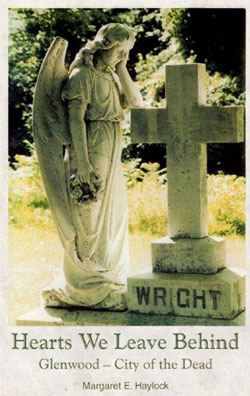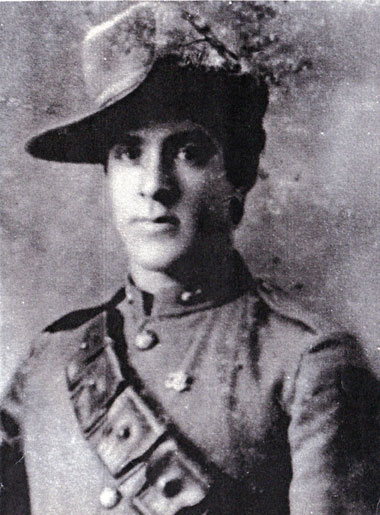James Livingston’s ‘The Fair’ became a successful chain store
Margaret Haylock-Capon | Jan 30, 2012 | Comments 1
Gone But Not Forgotten
By Margaret Haylock Capon
In the Victorian era, burial grounds such as Picton’s Glenwood Cemetery, consecrated in 1873, were known as Cities of the Dead. Street names were assigned to roadways, to further perpetuate this community concept and prestigious “neighbourhoods” for interment of the socially prominent were mapped out. In death, as in life, one could, indeed, secure an address on the right side of town.
Most small, rural cemeteries and churchyard burial grounds lack such formality but the monuments within them often have compelling stories to tell. Far from being “dead-end” ghost communities, Prince Edward County’s many cemeteries are alive with history. The famous and infamous lie within their gates, their stories written in stone to pique the interest of passers-by.
Gone But Not Forgotten will profile some of the colourful individuals buried in county graveyards and provide interesting insights regarding the memorials chosen to mark their final resting places.
James A. Livingston’s ‘The Fair’ became a successful chain store
An enterprising Picton businessman who once operated a chain of stores under the name of “The Fair”, J.A. Livingston was buried in Glenwood Cemetery, following his death in 1949. From small beginnings, he watched his holdings grow into a successful chain of stores featuring stock reminiscent of a country fair. Many different types of merchandise were offered for sale.
On April 1st, 1895, he opened his first store on Picton’s Main Street. His stock consisted of graniteware, tinware, and crockery. Livingston was the only staff member of the fledgling business, with the exception of a girl whom he hired to help out on Saturdays. From an original store with 560 feet of floor space, The Fair expanded, in 1930, to a 3,430-foot space, in addition to 3,690-foot basement area for stock purposes.
Livingston, initially, had moved to a storefront near the Bristol Block, then bought out the H.S, Wilcox store on the opposite side of the street. For a time, he operated a store on both sides of Main Street. In June, 1899, Fred Newman entered the business, as a partner, and a grocery department was added by buying the stock of merchant Hugh McGregor’s store. Circa 1902, Livingston and Newman opened a store in Wellington.
The Fair store in Picton proved so successful that Livingston found it necessary to move to a larger location (which would later become the site of Gentile’s Groceteria and Yanover’s). This double store had formerly been occupied by the Metropolitan Bank on one side and Young and Leslie Dry goods on the other.
As their business expanded, Livingston and Newman began to import directly from the Old Country and other European centres, as well as from the United States. In 1906, they purchased a wholesale stock of granite and tinware from Toronto and the following year opened a store in Napanee. In 1909, another store was opened in Gananoque.
In 1910, Newman sold his interest in the business back to Livingston, who carried on alone. He subsequently opened a branch in Trenton, in 1914, with Harry Doyle as manager and also operated a branch in Brighton for a time. He then bought out a Stouffville business and opened a branch of The Fair there, as well.
As Livingston grew older, he began to dispose of his holdings. The last business to be sold was the double store in Picton. Following his retirement he continued to remain busy, looking after several Picton properties he had retained. In 1947, he moved to Toronto, where he died at the age of 81.
The well-known Picton merchant was the charter president of the Picton Checkers Club and organized tournaments that were held annually in Belleville. A skilful competitor, he won the Eastern Ontario title on several occasions.
Livingston, also, was a life-long member of St. Andrew’s Presbyterian Church in Picton and a member of the Session. He also served on the board of management, was church treasurer and secretary of the Sunday School.
* * *
Charles Hart – Early Picton athlete
Recognized as an outstanding cricket and lacrosse player, Charles Hart was a leading member of the Picton Cricket Club, a group active in the 1890’s. He was also a member of the Quinte cricket team that won the Bay of Quinte Cricket Championship in 1897.
Born in Picton, in 1865, he was the son of George Henry Hart and, for many years was connected with the Hart and Son carriage factory which was founded by his grandfather. In 1904, he opened a general store adjacent to his residence on Talbot Street and this business venture proved highly successful.
In addition to being a talented cricket and lacrosse player, Hart was a noted baseball pitcher. He played on local teams, as early as 1886. An all-round athlete his name was synonymous with early sport in Picton and Prince Edward County.
Hart suffered a stroke in 1921 and never fully recovered from it. He died in 1930 and was buried in Picton’s Glenwood Cemetery.
* * *
Arthur Despard – A Hockey Sensation
The goal-keeper for Picton’s first hockey team, Arthur Despard was described in his obituary as “the sensation in hockey circles at the time.”
A native of Picton, Despard entered government service and moved to Ottawa, when a young man. In 1901 he began to visit many foreign countries where the Canadian government had displays in the great world fairs.
He was in charge of the Canadian building at the Panama Pacific International Exposition in San Francisco, at the Wembley Exhibition in England and at numerous other major exhibitions.
During the First World War, government activities were curtailed in regard to such exhibitions, but following the Armistice, Despard travelled extensively throughout the United States, furthering the work of the Department of Immigration and the Canadian Exhibition Commission, at many state fairs.
He was described as being “characteristically conscientious and zealous in his work in furthering the cause of Canada in foreign countries, by means of the exhibitions over which he had charge.”
Despard died in 1928, at the age of 51, and his body was brought back to Picton for burial in Glenwood Cemetery. His funeral service was held in Glenwood Chapel, with his brother, Rev. Gerald Despard of Toronto and Rev. Cecil Winter of Picton officiating.
* * *
John (Jack) Guest – Boer War Veteran and Veteran of The Great War
Born in Salford, England, in 1877, John Guest immigrated to Canada with his brother, Joe, when he was just 13 years old. Both youths settled in Prince Edward County, staying at the home of Capt. Fred Adams, whose son was Lt. Col. Adams.
One year, Capt. Adams took John Guest with him to a military camp in Kingston, an excursion that fuelled the young man’s interest in the army. Adams also arranged for Guest to visit Stanley Barracks in Toronto, where he learned to be a bugler. Following an additional course in Toronto he was promoted to the rank of sergeant. In Kingston, Guest transferred from the militia to the Royal Canadian Artillery. At the end of his tenure of service, he was discharged and returned to Picton. Soon, afterward, the South African War broke out. Guest re-enlisted and left on a troop ship bound for South Africa.
He was sent to serve in East Africa. Later his troop was ordered to march hundreds of miles to Rhodesia, where they were to join the Herbert Plumer troops who had been attempting, for several months, to relieve Baden Powell at Mafeking. The Canadian troops had several 12-pound guns with them.
They marched for eight days to reach Mafeking, where they set up their guns. When they opened fire, they were able to destroy one of the Boers’ big guns (Long Toms) and this led to the relief of Mafeking. However, the Boers were skilled fighters and even though they retreated, the war was not over.
Guest recalled that, on one occasion, when the Canadians were going by Pretoria, in pursuit of the Boers, Kitchener and Roberts watched as they galloped past.
Two Picton men, Guest and John Davenport, were among the Canadian soldiers who fought at the historic Relief of Mafeking. When Guest returned to Picton, he worked as a freight agent on the Central Ontario Railway, as well as at other jobs, until the outbreak of the Great War (World War l) in 1914.
In January, 1915, he joined up again and went overseas with the 39th Regiment. Wounded by shrapnel at Passchendaele, he was mistaken for dead. Medics carried him to a tent which was being used as a morgue. Two days later, someone heard him moaning and realized that he was still alive. He was taken to a field hospital where surgery was performed to remove the shrapnel embedded in his lung.
Guest returned to Canada after the war, but never fully recovered from his injuries. He was made quartermaster sergeant in charge of the Picton Armouries and when World War ll broke out, he handed out rifles and mothballed uniforms to the sons of his old comrades in arms.
Active in the Picton War Veterans’ Association, Guest served as an early president of Branch 78, Royal Canadian Legion. For a number of years, he was also a member of the Hastings and Prince Edward Regimental Band.
When he died, in 1954, veterans honoured him with an around-the-clock vigil beside his casket and a military salute was fired over his grave in Glenwood Cemetery.
His son, Azel, would later recall that he remained behind in the cemetery, to recite a verse of his father’s favourite poem which ended with the lines: “Blow, bugle, blow/Set the wild echoes flying/ Blow, bugle, answer echoes/ Dying, dying, dying.”
Footnote: John (Jack) Guest’s grave is marked with a large block of polished black granite. Atop it is mounted a Carrera marble angel, holding a sheaf of lilies in her arms. This stone was erected several years before his death, to mark the grave of his five-year-old daughter, Ruth, who was killed in a tragic accident. But that is a story for another time.
* * *
 -Margaret Haylock Capon, a freelance writer and former newspaper reporter, is the author of Hearts We Leave Behind, an illustrated history of Picton’s Glenwood Cemetery. She is a former member of both the Glenwood Cemetery board and the Prince Edward County Cemetery board. She and her husband, Alan R. Capon are Prince Edward County’s representatives of the Campbell Monument Company and co-authors of the company’s history, written during its centennial year (2009).
-Margaret Haylock Capon, a freelance writer and former newspaper reporter, is the author of Hearts We Leave Behind, an illustrated history of Picton’s Glenwood Cemetery. She is a former member of both the Glenwood Cemetery board and the Prince Edward County Cemetery board. She and her husband, Alan R. Capon are Prince Edward County’s representatives of the Campbell Monument Company and co-authors of the company’s history, written during its centennial year (2009).
Helping You Remember
Campbell Monument has now introduced an extended service for families ordering new inscriptions (i.e. final dates), for existing monuments. For an additional $85, upright monuments will also be power washed and checked for safety and stability. Ground level markers will be raised, levelled and cleaned. In Prince Edward County, please contact Margaret Haylock and Alan Capon at 613-393-2254 for further details.
Filed Under: Local News • Margaret Haylock-Capon
About the Author: Maggie Haylock is a freelance writer and former newspaper reporter who has co-authored several books with her husband, Alan Capon.

































Margaret Haylock Capon’s new book adds further insight to the resource that is Glenwood. Millennium Trail hikers can access Glenwood via a short Path to the Other Side by using West Mary, through Rotary Park (off Ontario), and voila, Glenwood’s more than 62 acres presents its greenery.